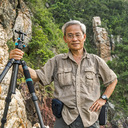0 Likes
Roštejn castle is a preserved Gothic-Renaissance castle, which lies not far from Telč. The Lords of Hradec had built it in the second quarter of the 14th century. The Renaissance reconstructions made under Zachariáš of Hradec after 1570 changed a bit of the function of the castle. The guard castle became a comfortable hunting chateau. A large park was established at the castle. In 1604, after the death of the last Lord of Hradec the castle fell into the hands of the family of Slavata, then the family of Lichtenstein and finally the ancestry of Podstatsští.
The Renaissance reconstruction in the 16th century preserved the Gothic bottoms of towers and also the dominating feature of Roštejn; a 28 metre high prismatic octahedral tower. There are valuable Renaissance wall paintings, period movables and collections in the castle interiors. In the largest chamber, the so-called fancy-dress hall, we can find a picture-gallery with more than forty paintings from the Renaissance and Rococo periods. The walls in armorial hall are decorated with more than 700 coat-of-arms from the period when the castle belonged to Slavata ancestry. The former park is now a botanic natural reservation.





The Czech Republic is a cool little landlocked country south of Germany and Poland, with a national addiction to pork and beer. Potatos, cabbage, and dumplings are close behind them, and they also have this great bar food called "utopenec." It means "a drowned man," it's pickled sausage with onions, perfect with some dark wheat bread and beer. The Czech bread is legendary, like a meal all by itself.Czechoslovakia first became a sovereign state in 1918 when it declared independence from the Austro-Hungarian Empire. The state of Czechoslovakia lasted until the "Velvet Divorce" of 1993, which created Slovakia and the Czech Republic.It was occupied by Germany in WWII but escaped major damage, unlike most other European cities. The nation's capital, Prague, retains some of Europe's most beautiful Baroque architecture as well as one of the largest medieval castle complexes still standing. The President of the Czech Republic has his offices in the Prague Castle even today.There was a coup d'etat in 1948 and Czechoslovakia fell under Soviet rule. For fifty years Czechoslovakia was a Socialist state under the USSR, subject to censorship, forced atheism and even the arrest of jazz musicians!In 1989, communist police violently squashed a pro-democracy demonstration and pissed everybody off so bad that a revolution erupted over it, finally ending the Communist rule.The next twenty years saw rapid economic growth and westernization. Today in Prague you can eat at McDonald's or KFC, shop for snowboarding boots and go see a punk rock show.The Czech Republic took over the presidency of the European Union in January 2009. This instantly created lots of political drama because the President of the Czech Republic, Vaclav Klaus, is a renowned Euroskeptic.We anxiously await the outcome of "President Klaus vs. the Lisbon Treaty", a world heavywieght fight sceduled for spring 2009.Text by Steve Smith.